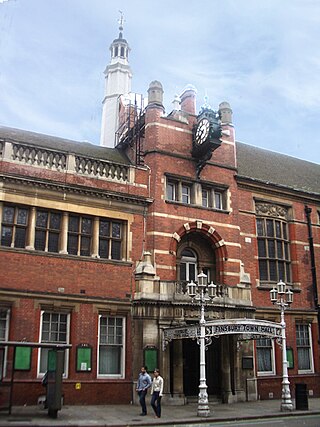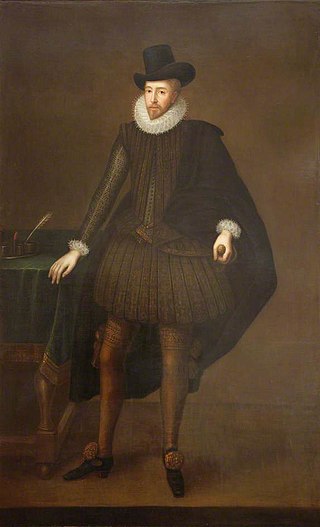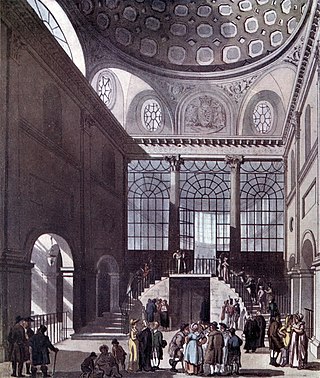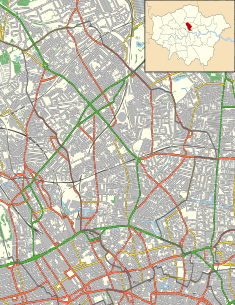In Great Britain and Ireland, a county town is the most important town or city in a county. It is usually the location of administrative or judicial functions within a county, and the place where public representatives are elected to parliament. Following the establishment of county councils in England 1889, the headquarters of the new councils were usually established in the county town of each county; however, the concept of a county town pre-dates these councils.

The London Borough of Islington is a London borough which forms part of Inner London, England. Islington has an estimated population of 215,667. It was formed in 1965, under the London Government Act 1963, by the amalgamation of the metropolitan boroughs of Islington and Finsbury.

Clerkenwell is an area of central London, England.

Islington is a district in the north of Greater London, England, and part of the London Borough of Islington. It is a mainly residential district of Inner London, extending from Islington's High Street to Highbury Fields, encompassing the area around the busy High Street, Upper Street, Essex Road, and Southgate Road to the east.

The Metropolitan Borough of Finsbury was a metropolitan borough within the County of London from 1900 to 1965, when it was amalgamated with the Metropolitan Borough of Islington to form the London Borough of Islington.

Islington was a civil parish and metropolitan borough in London, England. It was an ancient parish within the county of Middlesex, and formed part of The Metropolis from 1855. The parish was transferred to the County of London in 1889 and became a metropolitan borough in 1900. It was amalgamated with the Metropolitan Borough of Finsbury to form the London Borough of Islington in Greater London in 1965.

The Angel, Islington, is a historic landmark and a series of buildings that have stood on the corner of Islington High Street and Pentonville Road in Islington, London, England. The land originally belonged to the Clerkenwell Priory and has had various properties built on it since the 16th century. An inn on the site was called the "Angel Inn" by 1614, and the crossing became generally known as "the Angel". The site was bisected by the New Road, which opened in 1756, and properties on the site have been rebuilt several times up to the 20th century. The corner site gave its name to Angel tube station, opened in 1901, and the surrounding Angel area of London.

The Middlesex Guildhall is an historic court building in Westminster which houses the Supreme Court of the United Kingdom and the Judicial Committee of the Privy Council. The building stands on the south-western corner of Parliament Square, near the Palace of Westminster. In 1970, the building was listed Grade II*.

Upper Street is the main street of the Islington district of inner north London, and carries the A1 road. It begins at the junction of the A1 and Liverpool Road, continuing on from Islington High Street which runs from the crossroads at Pentonville Road and City Road and runs roughly northwards from outside the main entrance to Angel Underground station, then past the Business Design Centre, then splits at Islington Green, then past The Screen On The Green cinema, past Islington Town Hall, ending at Highbury & Islington tube station on Highbury Corner, where the A1 carries on as Holloway Road, part of the Great North Road.

Ossulstone is an obsolete subdivision (hundred) covering 26.4% of – and the most metropolitan part – of the historic county of Middlesex, England. It surrounded but did not include the City of London and the area has been entirely absorbed by the growth of London. It now corresponds to the seven London Boroughs of Inner London north of the Thames and, from Outer London, in decreasing order, certain historic parishes of the London boroughs of Ealing, Brent, Barnet, and Haringey.

Hicks Hall, or Hickes' Hall, was a courthouse at the southern end of St John Street, Clerkenwell, London. It opened in 1612, and was closed and demolished in 1782. It was the first purpose-built sessions house for justices of the peace of the county of Middlesex, and became the main court of petty sessions and arraignment for more serious offences, including cases involving plots, attacks and minor transgressions against the state.

The Inner London Sessions House Crown Court, more commonly known as the Inner London Crown Court and distinct from the Inner London Magistrates' Court, is a Crown Court building in Newington, London, United Kingdom. It is located in the Sessions House on Newington Causeway at the corner of Harper Road. It is a Grade II listed building.

St Luke's is an area in London, England and is located in the London Borough of Islington. It lies just north of the border with the City of London near the Barbican Estate, and the Clerkenwell and Shoreditch areas.

A sessions house in the United Kingdom was historically a courthouse that served as a dedicated court of quarter sessions, where criminal trials were held four times a year on quarter days. Sessions houses were also used for other purposes to do with the administration of justice, for example as a venue for the courts of assize (assizes). The courts of quarter sessions and assize, which did not necessarily sit in dedicated premises, were replaced in England by a permanent Crown Court by the Courts Act 1971, and in 1975 in Scotland by other courts. Several buildings formerly used as sessions houses are still named "Sessions House"; some are still used for the administration of justice, while others have different uses. Some are listed buildings of architectural importance.

The Sessions House is a former judicial building on George Row in Northampton, England. The Sessions House, which was the main courthouse for Northamptonshire, is currently used as a tourist information centre and is a Grade I listed building. The building is adjacent to County Hall, the meeting place of Northamptonshire County Council.

The Angel is an area on the northern fringes of Central London within the London Borough of Islington. It is 2 miles (3.2 km) north-northeast of Charing Cross on the Inner Ring Road at a busy transport intersection. The area is identified in the London Plan as one of 35 major centres in London. It is a significant commercial and retail centre, and a business improvement district. The Angel straddles the ancient boundary of the parishes of Clerkenwell and Islington that later became the metropolitan boroughs of Finsbury and Islington. It is named from the former Angel Inn which stood on the corner of Islington High Street and Pentonville Road. Since 1965 the whole area has formed part of the London Borough of Islington in Greater London.

Baptist Hicks, 1st Viscount Campden was an English cloth merchant and politician who sat in the House of Commons between 1621 and 1628. King James I knighted Hicks in 1603 and in 1620 he was created a baronet.
Frederick Hyde Pownall was a British architect. He was County Surveyor for Middlesex for about 45 years, and designed both Anglican and Roman Catholic churches.

The Middlesex Quarter Sessions was the quarter session court for the county of Middlesex, England. Membership was made up of the justices of the peace. The quarter sessions heard criminal cases and also had a role in the civil administration of the county. Administrative functions of the quarter sessions lasted from the 16th century to 1889 and included taxation, licensing, prisons, asylums and bridges. The Middlesex sessions area was reduced in 1889.

Finsbury Town Hall is a municipal building in Finsbury, London. The structure is a Grade II* listed building.




















